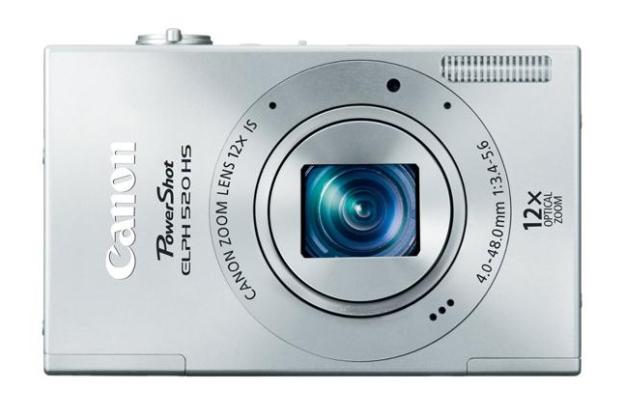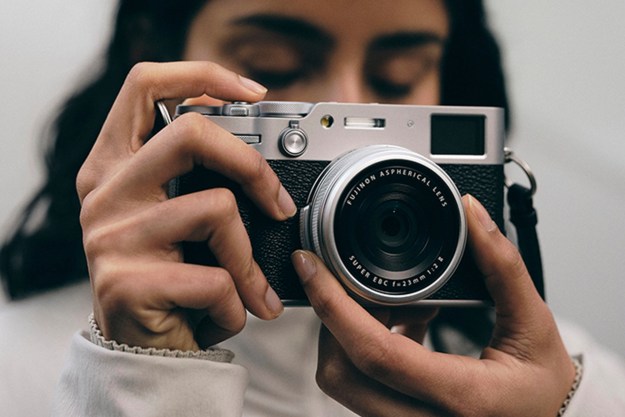
“This is a camera for someone who finds they’ve outgrown their basic point-and-shoot and wants to start dipping their toe into manual settings.”
- High-speed burst mode
- Good-looking and super portable
- Quality photos and videos
- Easy to use
- Poor battery life
- MicroSD only
- Average low light performance at best
The Canon Elph 520 HS is a slim, sleek and powerful little camera. You can think of the Elph series like the PowerShot’s offbeat, eccentric cousin: It looks and acts a little different, which makes for some awkward moments here and there, but it more than makes up for it with quality and creativity. To sum it up, the Elph series brings a little variety to what can be a somewhat monotonous table. While there are some hang-ups here and there with the $300 Elph 520 HS, it offers a surprisingly satisfying experience.
What’s in the box
Besides your Elph 520 HS digital camera, you’ll get the battery, its charger, USB cable, wrist strap, and CD-ROM. Normal affair for a camera like this.
Looks and feels
Right out of the box, the Elph 520 HS is a good-looking camera. The camera’s boxy with hard, angular edges – it’s a nice deviation from the softer-looking point-and-shoots on the market. Save for the shutter/zoom toggle on top of the camera, the Elph’ssurface is entirely smooth and flat. It’s almost military-like in its minimalism, with fewer buttons and controls than many competitor cameras.

The back of the camera is dominated by its 3-inch LCD display, and designated video capture, exposure, macro view, flash, function, menu, and display controls lying off to the side. There isn’t a mode dial of any sort on this camera.
As far as feel goes, you’ve probably gathered by now that the Elph 520 HS is small and quite possibly too small for big hand. This, coupled with its smooth form-factor means there isn’t a lot of grip to be had. The top of the camera has a small, grip-area for one-handed shooting, but it isn’t much. It’s also heavier than you might expect looking at it however, and in my book that’s a plus. The Elph 520 is lightweight enough not to aggravate your wrist, but it doesn’t feel like you’re about to crush the dainty thing in your paws. There’s little to no wiggle on the lens, and we wouldn’t expect such a thing in a Canon point-and-shoot.
UI and navigation
Canon cameras are notoriously easy to use, and the Elph 520 HS is no exception. On the top of the camera you will find controls are neatly laid out. You have two options: You can switch to Auto, or you can switch to Program (the camera icon). When in Auto, you’re still able to control things like flash and Macro settings (which is one of the things the camera can determine on its own thanks to its Smart Auto technology).
There’s nothing to keep you from switching to Auto and shooting away, and it’s probably even easier than in most camera to defer to this setting thanks to the camera-top toggle.

It’s not like the manual settings in the Elph 520 HS are that difficult to master either. Switch over to Program, hit the “function” button, and you can navigate all of your options in the left-hand column of the screen. Everything is put as plainly as possible: In as few words as possible, the features and what they do are spelled out, and you use the four middle buttons on the back of the chassis to control them.
The screen’s UI during shooting doesn’t deviate from other point-and-shoots too much, so there’s some familiarity here. If you want to go without, hitting Display gives you a big, clear, nothing-but-LCD view (which is a good option, and I realize largely impractical, but still great to have). Navigating the features built into the camera is different – but not worse – than in competitor cameras. But the simplicity here is incredibly usable and easy to warm up to instantly. There’s nothing off-putting or wearisome about it.
Features
The Elph 520 HS keeps up with typical point and shoot fashion but including a good many features. First, let’s start with all your creative options. You can determine what colors really pop, and there are fish-eye, miniature, toy camera, soft focus, super vivid, and poster effects. You also have plenty of pre-set scene options, like low light, snow, fireworks, etc.
But there are a few important features that stand out. For starters, the cameras high-speed burst mode. Canon says this tool allows for continuous shooting at 6.8fps. Now that’s fast, but the problem is that it’s not quite as fast as its predecessor, the Elph 510 HS. Which is perhaps where most of the complaints about the Elph 520 HS come from – it just doesn’t pack quite the feature punch that the 510 HS did. Gone is the touchscreen, with it the 3.2-inch display, the 7.8fps burst mode, and arguably most annoyingly an SD card slot. The Elph 520 HS only accept microSD cards, meaning you can’t pop that thing in and out of laptops with built-in SD readers. It’s not a major grievance, but surprisingly aggravating.

Really, none of these “steps backward” would seriously bother anyone who doesn’t currently own or previously owned the Elph HS 510. You still have a more than adequate 12x optical zoom, a bright 3-inch LCD that gets the job, a high-sensitivity 10.1-megapixel CMOS sensor plus the power of the DIGIC 5 processor ( the 510 has a 12.1-megapixel sensor, but the DIGIC 4 processor). It’s also much better looking, smaller, and bumps it up with little things like a dedicated movie button and improved intelligent auto settings.
In short, given how many features are bit of a downgrade, the Elph 520 HS still has a lot to show off (not to mention it’s selling at $50 cheaper than the 510 did at launch).
Performance and use
It can’t be emphasized enough how tiny this camera is. It’s quite small, and it’s much boxier than other point-and-shoots, so it’s probably going to feel unfamiliar at first. But I came around to the Elph 520 HS’ quirky shape quickly.
The Elph 520 HS combated handshake with ease, and a blurry photo was hard to come by. Without much thought, on Program or Auto, you’re able to take quality stills. Of course, resolution won’t hold up to more expensive pocket cams or DSLRs – this should go without saying. But the images can be quite crisp, particularly compared to its basic point-and-shoot brethren. Colors popped without photos being overly-saturated and high-speed burst mode was able to capture vehicles speeding by on the freeway. 1080p full HD video is also crisp and using zoom during wasn’t too shaky either.
Like most Canon point- and-shoots, the Elph 520 HS is not made for low light environment. The upgraded processor showed an improvement in this, but you’re still going to find yourself relying on a flash or a tripod in dark settings.
As far as more utilitarian tasks go, I was generally pleased with quick AF and recycle time. But the Elph 520 HS isn’t without its faults – namely, battery life and its microSD card exclusivity. Like the 510, battery life is disappointing. If you’re going to be using this camera on the go, investing in an extra battery would be wise. Only using a microSD card is frustrating; every computer I use has at least one SD card reader built-in. I hate the idea of lugging around the USB cable to upload photos – and yes, I understand how insignificant it might seem, but I like my cameras with all their necessary parts contained within the device itself (save for the battery charger, obviously). This is the sacrifice you make for such a tiny camera though.

Conclusion: Should you buy it?
The Elph 520 HS is a hard sell. Looking at only the specifications, you might not see enough of an upgrade here to justify the purchase. But once it’s actually in your hands, you can see where it proves its worth. The button navigation gets rid of the touchscreen interface (overrated, in my opinion) and makes handling more in your control. The DIGIC 5 processor works some new magic, and Canon outfits it with expanded features – not to mention puts it all in a much better looking package.
So should you buy it? This is a camera for someone who finds they’ve outgrown their basic point-and-shoot and wants to start dipping their toe into manual settings – plus, creative filters are basically a must in this genre now. So if what you’re working with doesn’t have this, you’re probably due for an upgrade.
If you have the Elph 510 HS or a newer point-and-shoot camera however, there is no need to get the 520.
Also worth noting, buyers interested in using a point-and-shoot for action shots (daytime action shots in particular) should take notice. You’re not going to find a feature like that in many cameras this size, so if you want to throw your camera in your bag or purse or car and forget about it until the all important soccer game, the Elph 520 HS makes some pretty persuasive offers.
Highs:
- High-speed burst mode
- Good-looking and super portable
- Quality photos and videos
- Easy to use
Lows:
- Poor battery life
- MicroSD only
- Average low light performance at best










